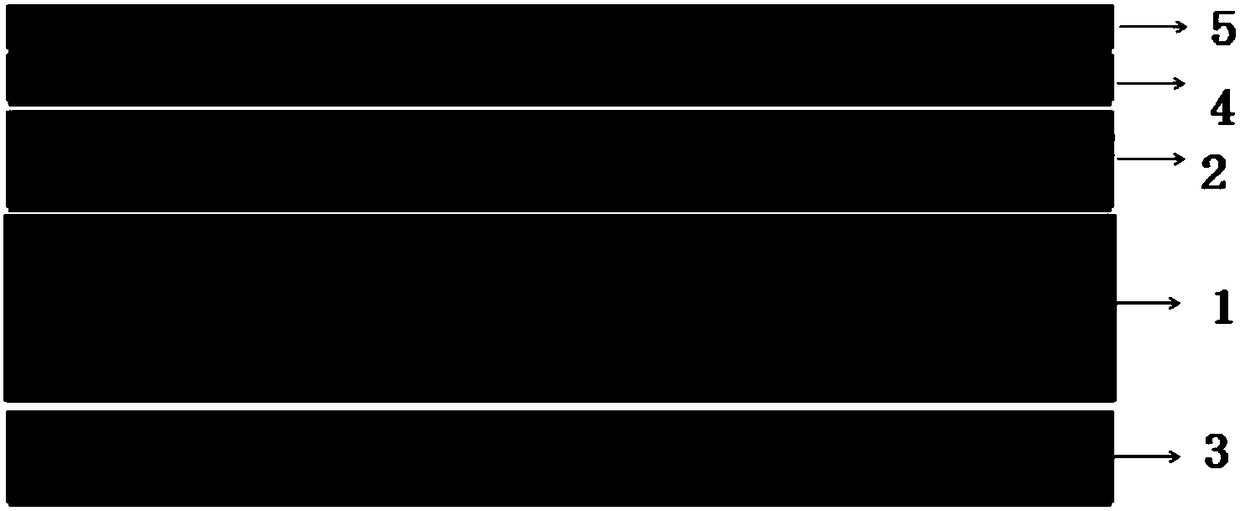Color ceramic
A ceramic and color technology, applied in the field of ceramics, can solve the problems that the surface coating is easy to cause the warpage of the porcelain body, the color cannot be changed, and the deformation amount is inconsistent, so as to improve the hardness and scratch resistance, and ensure the stability and consistency. , The effect of improving the wear resistance and scratch resistance
- Summary
- Abstract
- Description
- Claims
- Application Information
AI Technical Summary
Problems solved by technology
Method used
Image
Examples
Embodiment 1
[0043] An embodiment of the colored ceramics described in the present invention, a structural schematic diagram of the colored ceramics described in this embodiment is as attached figure 1 Shown:
[0044] A colored ceramic, comprising a roughened ceramic surface 1, the roughness Ra of the ceramic surface 1 is 0.01-0.5 μm; the upper part of the ceramic surface 1 is sequentially provided with a colored layer 2, SiO 2 Layer 4, AF film layer 5, an ink layer 3 is printed on the lower part of the ceramic surface 1, and the color layer 2 is a stacked film layer in which the first film layer and the second film layer are alternately arranged, wherein the first film layer has a high refractive index Regarding the refractive index of the second film layer, the first film layer is PZT; the second film layer is MgO; the thickness of the color layer 2 is 1 nm, the thickness of the ink layer 3 is 50 μm, SiO 2 The thickness of layer 4 is 1 nm, and the thickness of AF film layer 5 is 1 nm. ...
Embodiment 2
[0047] An embodiment of the colored ceramics described in the present invention, a structural schematic diagram of the colored ceramics described in this embodiment is as attached figure 1 Shown:
[0048] A colored ceramic, comprising a roughened ceramic surface 1, the roughness Ra of the ceramic surface 1 is 0.015-0.2 μm; the upper part of the ceramic surface 1 is sequentially provided with a colored layer 2, SiO 2 Layer 4, AF film layer 5, an ink layer 3 is printed on the lower part of the ceramic surface 1, and the color layer 2 is a stacked film layer in which the first film layer and the second film layer are alternately arranged, wherein the first film layer has a high refractive index The refractive index of the second film layer; the first film layer is BaTiO 3 ; The second film layer is MgF 2 ; The thickness of color layer 2 is 1500nm, the thickness of ink layer 3 is 0μm, SiO 2 The thickness of layer 4 is 50nm, and the thickness of AF film layer 5 is 50nm.
[0049...
Embodiment 3
[0051] An embodiment of the colored ceramics described in the present invention, a structural schematic diagram of the colored ceramics described in this embodiment is as attached figure 1 Shown:
[0052] A colored ceramic, comprising a roughened ceramic surface 1, the roughness Ra of the ceramic surface 1 is 0.01-0.5 μm; the upper part of the ceramic surface 1 is sequentially provided with a colored layer 2, SiO 2 Layer 4, AF film layer 5, an ink layer 3 is printed on the lower part of the ceramic surface 1, and the color layer 2 is a stacked film layer in which the first film layer and the second film layer are alternately arranged, wherein the first film layer has a high refractive index in the refractive index of the second film layer; the first film layer is Ta 2 o 5 ; The second film layer is Y 2 o 3 ; The thickness of color layer 2 is 750nm, the thickness of ink layer 3 is 25μm, SiO 2 The thickness of layer 4 is 25nm, and the thickness of AF film layer 5 is 25nm. ...
PUM
| Property | Measurement | Unit |
|---|---|---|
| thickness | aaaaa | aaaaa |
| thickness | aaaaa | aaaaa |
| thickness | aaaaa | aaaaa |
Abstract
Description
Claims
Application Information
 Login to View More
Login to View More - R&D
- Intellectual Property
- Life Sciences
- Materials
- Tech Scout
- Unparalleled Data Quality
- Higher Quality Content
- 60% Fewer Hallucinations
Browse by: Latest US Patents, China's latest patents, Technical Efficacy Thesaurus, Application Domain, Technology Topic, Popular Technical Reports.
© 2025 PatSnap. All rights reserved.Legal|Privacy policy|Modern Slavery Act Transparency Statement|Sitemap|About US| Contact US: help@patsnap.com



